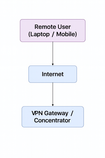MPLS: Optimizing WAN Performance and Scalability
- The Itvue Team
- Aug 21
- 2 min read
Author Ermias Teffera
At ITVue Networks, building high-performance, resilient WANs is critical for enterprise clients. After exploring Fiber, SDH/SONET, Metro Ethernet, and VPLS, we now turn to MPLS (Multiprotocol Label Switching) — a versatile WAN technology that enhances traffic management, scalability, and reliability across complex networks.
What is MPLS?
MPLS is a packet-forwarding technology that uses labels to make high-speed routing decisions across a provider backbone. Unlike traditional IP routing, which looks at the destination IP address for each hop, MPLS uses a label attached to each packet to determine the next hop.
Key Benefits:
High-speed packet forwarding using label switching
Traffic engineering for optimal path selection
Supports Layer 2 and Layer 3 VPNs (VPLS, L3VPN)
Enables QoS and service differentiation
MPLS Components
Customer Edge (CE) Router
Connects the customer network to the provider
Can be a PE or directly connect via L3VPN/MPLS
Provider Edge (PE) Router
Terminates MPLS VPNs and applies labels to customer traffic
Connects to CE routers and participates in MPLS backbone
Provider Core (P) Router
High-speed label switching within the backbone
Only switches labeled packets, not aware of customer IPs
MPLS Forwarding Mechanism
Label Assignment: Each PE router assigns a label to a packet based on its destination
Label Switching: P routers forward the packet based on the label, not the IP address
Label Removal: The egress PE router removes the MPLS label and forwards the packet to the CE
Diagram: MPLS Core with PE and P Routers

CE routers connect to PE routers at the edge of the MPLS network
PE routers label traffic for MPLS forwarding
P routers in the core switch labeled packets at high speed
Traffic emerges at the destination PE, then to CE
MPLS Services
MPLS L3VPN
Layer 3 VPN across the provider network
Each customer has a separate routing table
Supports scalable multi-customer deployments
MPLS L2VPN / VPLS
Extends Layer 2 connectivity across MPLS backbone
Supports Ethernet VPNs and multipoint connections
MPLS Traffic Engineering
Directs traffic over less-congested paths using Constraint-Based Routing
Supports load balancing and redundancy
Cisco Configuration Example (L3VPN)


VRF creates a separate routing table for the customer
BGP distributes routes across MPLS backbone with labels
Real-World Applications
Connecting multiple branch offices across a city, region, or country
Providing L3VPN services for enterprise customers with separate routing tables
Supporting VPLS services over an MPLS backbone for LAN extension
Traffic engineering for QoS-sensitive applications like VoIP and video
Best Practices
Deploy redundant PE and P routers for high availability
Use traffic engineering (MPLS-TE) to optimize bandwidth usage
Combine MPLS with EtherChannel and ECMP for link aggregation and load balancing
Monitor MPLS labels, VRF tables, and path utilization with show mpls forwarding-table and show ip bgp vpnv4 all
Conclusion
MPLS is a highly flexible and scalable WAN technology that enables enterprises to extend networks, provide VPN services, and optimize traffic across large geographies. By leveraging VRFs, MPLS-TE, and VPLS, ITVue Networks delivers high-performance, reliable, and SLA-backed WAN solutions for modern businesses.










Comments